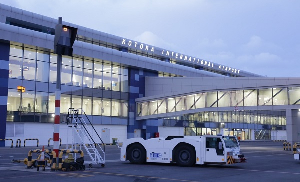The rate of road accidents in the country is on the ascendency, and will soon reach an alarming height if radical measures are not put in place to check the major factors that contribute to the unpleasant development.
Worse than the mere occurrence of motor accidents in the country, is the fact that many of the country’s vibrant and economically active population perish through them.
Having gathered and analyzed data on road accidents in the country for nine consistent years, it is certain that the factors that promote road accidents in the country have prevailed over the years.
After a careful review of the major roads that see the most number of accidents involving fatalities, it seems much understandable as to why road carnage persists in the country, and is gradually becoming a not-so-alarming news item until it involves a person of great repute and high social standing.
Until famous Ghanaian singer, Ebony died in a terrible road accident in January 2018 at Mankranso in the Ashanti Region, many people had not awakened to the danger the current state of the road posed to motorists.
But after a few months, many of us carried on with life as though everything was fine, although hundreds continue to die through road accidents in the country.

Guard-rails destroyed as a result of a motor accident
The cost of road crashes
For every life that is lost in a road crash in Ghana, at least two other relatives or dependents have their source of daily bread taken away and dreams shattered.
To the country, hundreds or thousands of dollars is spent on each accident victim anytime such incident occur.
This excludes the value persons who lose their lives in such incidents would have added to the economy but for their demise.
Road accidents in Ghana also often leave in their wake destruction of public properties including advanced directional signs, traffic lights, crash barriers, street lights and guard rails.
According to a report of the World Health Organization, road traffic injuries account for almost 1.2 million deaths a year around the world, and for 20–50 million injuries or disabilities.
It notes that the economic cost of road crash injuries is roughly 1% of the gross national product in low?income countries, 1.5% in middle?income countries and 2% in high?income countries.
A Senior Specialist on Trauma and Orthopaedic Surgery at the Komfo Anokye Teaching Hospital, Dr. Dominic Konadu Yeboah recently indicated that about $230 million is spent annually on emergency and trauma care from motor accidents alone.
This amount is enough to build about 2,000 6-unit classroom blocks in one year to promote formal education.
What the figures say
Between 2004 and 2013, there has been over 20,000 road crashes with about 35,200 casualties on just the country’s major intercity highways.
In fact, in 2018 alone, there were 13,000 reported cases of road accidents across the country, with 15,000 casualties including deaths.
The previous year, the figures were slightly lower as the number of reported accident cases were 12,000 and the number of casualties including deaths was about 14,000.

The most dangerous highways
13 major highways in the country were assessed for road crashes within the 9-year period, and the top 7 selected by virtue of the frequency of road accidents on those stretches are as follows:
1. Accra – Cape Coast road – The stretch is 145 kilometers long via the N1 Highway. Within the 9 year period, there were 6,104 road crashes on that stretch with 7,465 casualties. This means that, consistently for 9 years, 2 people died or got injured in road crashes on that stretch every single day.
2. Aflao – Accra road – This stretch is 187 kilometers of the N1 highway and has recorded 3,919 road accidents in the year under review. 6,826 persons got injured or died from the incidents.
3. Tema – Hohoe road: 191 kilometers long. This stretch recorded 1,965 road crashes with 4,393 people being casualties. This makes it an average of 2 persons getting injured or dying from each reported accident on the stretch via the N2 highway.
4. Kumasi – Techiman: This is a 126-kilometer stretch using the N10 highway. In 9 years, 1,702 road crashes were officially recorded on this stretch. This resulted in 3,481 casualties, indicating that each accident left about 2 people dead or injured.
5. Kintampo – Tamale: 939 road crashes occurred on this stretch within the years under review via the N10 highway with 2,523 casualties. The stretch is 196 kilometers.
6. Takoradi – Elubo: The 130-kilometer road via the N1 highway has seen 839 road crashes within 9 years and 1,425 casualties as a result.
7. Tamale – Bolga: On this stretch, 780 motor accidents were recorded with 1,696 casualties. The stretch is located on the N10 highway and is approximately 160 kilometers long.
Other major roads accessed were, Techiman to Kintampo, Sunyani to Bamboi, Bamboi to Wa, Hohoe to Nkwanta and Nkwanta to Yendi, all of which recorded less than 550 road crashes and less than 1,200 casualties.
There are many reasons that account for the high number of road crashes, particularly along the N1 highway which constitutes over 40% of the major accident-prone roads in the country.
While some of the accidents are caused by road users; that is excessive speeding, drink-driving, unsafe overtaking, and carelessness, others are caused by the vehicular defects such as failure in brake systems and burst tyres.
Also, some of the accidents are caused by the poor road designs and road conditions such as potholes, bad roads lack of street lights, sharp curves and obstructions such as heaps of sand and broken-down vehicles.

It is worth noting that less than 30% of the country’s roads are paved, according to the 2016 Ghana Infrastructure Report Card.
The solutions to these challenges are not only known, but are within implementation reach for road safety stakeholders in Ghana as captured in various documents including road safety plans and strategies as well as reports from consultative meetings.
The National Road Safety Commission (NRSC), Ministry of Roads and Highways, Ghana Highways Authority (GHA), Transport Ministry, Department of Urban Roads and the Department of Feeder Roads are but a few of the institutions whose roles are directly linked with the safety of roads in the country for motorists, passengers and pedestrians.
It is a fact that, carnages on the country’s roads will not be dealt with if the abovementioned institutions do not commit to the process.
For a country whose economy is labour intensive, the continuous loss of citizens through road traffic fatalities has a huge impact on the growth rate of the economy.
It is therefore impossible to have the economy grow exponentially without addressing the factors that promote road accidents in the country.
Whatever it takes, Ghanaian lives must matter.
Opinions of Friday, 25 January 2019
Columnist: Jonas Nyabor







![Dr. Bawumia [L] and J.A Kufuor Dr. Bawumia [L] and J.A Kufuor](https://cdn.ghanaweb.com/imagelib/pics/589/58948438.295.jpg)











